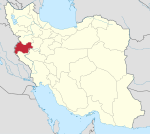Kermanshah
Kermanshah
| |
|---|---|
City | |
|
Panoramic, Takyeh Beyglarbeygi, Imad Doulah Mosque, Takyeh Moaven-ol-Molk (Tekiye Moaven Al Molk), Jameh Mosque of Shafei, Taq-e Bostan | |
| Nickname(s): The Land of History & Myths; The Land of Eternal Lovers; The Land of Shirin & Farhad | |
| Coordinates: 34°20′13″N 47°05′28″E / 34.33694°N 47.09111°E[1] | |
| Country | Iran |
| Province | Kermanshah |
| County | Kermanshah |
| District | Central |
| Established date | 390 AD |
| Government | |
| • Mayor | Nader Norouzi |
| Elevation | 1,350 m (4,430 ft) |
| Population (2016) | |
| • Urban | 946,651[2] |
| • Metro | 1,083,833[3] |
| • Demonym | Kermashani Kermanshahi |
| Time zone | UTC+3:30 (IRST) |
| Postal code | 67146 |
| Area code | 083 |
| Climate | Csa |
| Website | kermanshah |
 | |
Kermanshah (Kurdish: کرماشان) (Persian: کرمانشاه; [keɾmɒːnˈʃɒː] ⓘ)[a] is a city in the Central District of Kermanshah province, Iran, serving as capital of the province, the county, and the district.[5]
The city is 525 kilometres (326 miles) from Tehran in the western part of the country.
The 2016 National Census measured the population of the city as 946,651[2] (2021 estimate 1,047,000).[6]
Etymology
[edit]"Kermanshah" derives from the Sasanian-era title Kirmanshah, which translates as "King of Kerman".[7]
Famously, this title was held by the son of Shapur III, Prince Bahram, who was bestowed with the title upon being appointed governor of the province of Kirman (present-day Kerman Province).[8][7]
Later, in 390, when he had already succeeded his father as Bahram IV Kirmanshah (r. 388–399), he founded the city and his title was applied to it, i.e. "(City of the) King of Kirman".[9][10]
History
[edit]| Year | Pop. | ±% p.a. |
|---|---|---|
| 1986 | 560,514 | — |
| 1991 | 624,084 | +2.17% |
| 1996 | 692,986 | +2.12% |
| 2006 | 794,863 | +1.38% |
| 2011 | 851,405 | +1.38% |
| 2016 | 946,651 | +2.14% |
| source:[11] | ||
Prehistory
[edit]
Because of its antiquity, attractive landscapes, rich culture and Neolithic villages, Kermanshah is considered one of the cradles of prehistoric cultures. According to archaeological surveys and excavation, the Kermanshah area has been occupied by prehistoric people since the Lower Paleolithic period, and continued to later Paleolithic periods until late Pleistocene period. The Lower Paleolithic evidence consists of some hand axes found in the Gakia area to the east of the city. The Middle Paleolithic remains have been found in various parts of the province, especially in the northern vicinity of the city in Tang-e Kenesht, Tang-e Malaverd and near Taq-e Bostan.

Neanderthal Man existed in the Kermanshah region during this period and the only discovered skeletal remains of this early human in Iran was found in three caves and rock shelter situated in Kermanshah province.[12] The known Paleolithic caves in this area are Warwasi, Qobeh, Malaverd and Do-Ashkaft Cave. The region was also one of the first places in which human settlements including Asiab, Qazanchi, Sarab, Chia Jani, and Ganj-Darreh were established between 8,000 and 10,000 years ago.
This is about the same time that the first potteries pertaining to Iran were made in Ganj-Darreh, near present-day Harsin.
In May 2009, based on a research conducted by the university of Hamadan and UCL, the head of Archeology Research Center of Iran's Cultural Heritage and Tourism Organization announced that one of the oldest prehistoric villages in the Middle East dating back to 9800 B.P. was discovered in Sahneh, located west of Kermanshah.[13][14]
Remains of later village occupations and early Bronze Age are found in a number of mound sites in the city itself.
The city contains 4 archaeological mound sites: Chogha Kaboud, Chogha Golan, Morad Hasel, and Tappa Gawri.
Sassanid Kermanshah
[edit]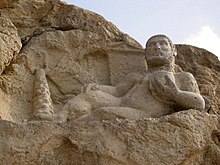
In ancient Iranian mythology, construction of the city is attributed to Tahmuras, the third king of Pishdadian dynasty. It is believed that the Sassanids have constructed Kermanshah and Bahram IV (he was called Kermanshah, meaning king of Kerman) gave his name to this city.[15]
It was a glorious city in Sassanid period about the 4th century AD when it became the capital city of Persian Empire and a significant health center serving as the summer resort for Sassanid kings. In AD 226, following a two-year war led by the Persian Emperor, Ardashir I, against "Kurdish" tribes in the region, the empire reinstated a local "Kurdish" prince, Kayus of Medya, to rule Kermanshah.[citation needed] At the time, the term "Kurd" was used as a social term, designating Iranian nomads, rather than a concrete ethnic group.[16][17] The word became an ethnic identity in the 12th and 13th century.[18][19] Within the dynasty known as the House of Kayus (also Kâvusakân) remained a semi-independent kingdom lasting until AD 380 before Ardashir II removed the dynasty's last ruling member.[citation needed]
Islamic era
[edit]Kermanshah was conquered by the Arabs in 629 AD. Under Seljuk rule in the eleventh century, it became the major cultural and commercial center in western Iran and the southern Kurdish-inhabited areas as a whole. It was sacked by the Mongols under Hulegu in 1257, shortly before the sack of Baghdad. The Safavids fortified the town, and the Qajars repulsed an attack by the Ottomans during Fath Ali Shah's rule (1797–1834). Kermanshah was occupied by Ottomans between 1723–1729 and 1731–1732.[citation needed]
Modern history
[edit]Occupied by the Imperial Russian army in 1914, followed by the Ottoman Army in 1915 during World War I, it was evacuated in 1917 when the British forces arrived there to expel the Ottomans. Kermanshah played an important role in the Iranian Constitutional Revolution during the Qajar dynasty period and the Republic Movement in Pahlavi dynasty period. The city was harshly damaged during the Iran–Iraq War, and although it was rebuilt, it has not yet fully recovered.[citation needed]
Demographics
[edit]Population
[edit]At the time of the 2006 census, the city's population was 784,602 in 202,588 households.[20] The following census in 2011 counted 851,405 people in 242,311 households.[21]
The language of the native people in Kermanshah is South Kurdish, but the people of Kermanshah can also speak standard Persian. A minority in the city speak Kermanshahi Persian, a local dialect which differs from standard Persian.[22] The city has the largest Kurdish population in Iran.[23][24][25] Kermanshah has a moderate and mountainous climate.[26][27][28][29] Most of the inhabitants of Kermanshah are Sunni Muslims, but there are also Shia Muslims, Christians,[30] and followers of Yarsanism.[31][32]
Climate
[edit]Kermanshah has a climate which is heavily influenced by the proximity of the Zagros mountains, classified as a hot-summer Mediterranean climate (Köppen: Csa; Trewartha: Dohk) bordering on a humid continental climate (Dsa). The city's altitude and exposed location relative to westerly winds makes precipitation a little bit high (more than twice that of Tehran), but at the same time produces huge diurnal temperature swings especially in the virtually rainless summers, which remain extremely hot during the day. Kermanshah experiences rather cold winters and there are usually rainfalls in fall and spring. Snow cover is seen for at least a couple of weeks in winter.
Highest recorded temperature: 44.1 °C (111.4 °F) on 13 July 1998
Lowest recorded temperature: −27.0 °C (−16.6 °F) on 6 February 1974[33]
| Climate data for Kermanshah (1991–2020, extremes 1951–2020) | |||||||||||||
|---|---|---|---|---|---|---|---|---|---|---|---|---|---|
| Month | Jan | Feb | Mar | Apr | May | Jun | Jul | Aug | Sep | Oct | Nov | Dec | Year |
| Record high °C (°F) | 20.2 (68.4) |
21.8 (71.2) |
28.4 (83.1) |
33.7 (92.7) |
38.5 (101.3) |
43.0 (109.4) |
44.1 (111.4) |
44.0 (111.2) |
40.4 (104.7) |
34.4 (93.9) |
28.4 (83.1) |
25.4 (77.7) |
44.1 (111.4) |
| Mean daily maximum °C (°F) | 8.8 (47.8) |
11.3 (52.3) |
16.0 (60.8) |
21.3 (70.3) |
27.5 (81.5) |
34.9 (94.8) |
38.8 (101.8) |
38.6 (101.5) |
33.6 (92.5) |
26.2 (79.2) |
16.9 (62.4) |
11.5 (52.7) |
23.8 (74.8) |
| Daily mean °C (°F) | 2.6 (36.7) |
4.7 (40.5) |
9.0 (48.2) |
13.8 (56.8) |
19.1 (66.4) |
25.7 (78.3) |
29.4 (84.9) |
28.9 (84.0) |
23.7 (74.7) |
17.3 (63.1) |
9.5 (49.1) |
4.9 (40.8) |
15.7 (60.3) |
| Mean daily minimum °C (°F) | −2.9 (26.8) |
−1.5 (29.3) |
2.0 (35.6) |
6.1 (43.0) |
9.6 (49.3) |
13.9 (57.0) |
17.9 (64.2) |
17.4 (63.3) |
12.4 (54.3) |
8.3 (46.9) |
2.9 (37.2) |
−1.0 (30.2) |
7.1 (44.8) |
| Record low °C (°F) | −24.0 (−11.2) |
−27.0 (−16.6) |
−11.3 (11.7) |
−6.1 (21.0) |
−1.0 (30.2) |
2.0 (35.6) |
8.0 (46.4) |
8.0 (46.4) |
1.2 (34.2) |
−3.5 (25.7) |
−17.0 (1.4) |
−17.0 (1.4) |
−27.0 (−16.6) |
| Average precipitation mm (inches) | 57.1 (2.25) |
56.0 (2.20) |
68.4 (2.69) |
59.0 (2.32) |
25.5 (1.00) |
1.0 (0.04) |
0.9 (0.04) |
0.3 (0.01) |
2.6 (0.10) |
32.9 (1.30) |
61.1 (2.41) |
51.6 (2.03) |
416.4 (16.39) |
| Average precipitation days (≥ 1.0 mm) | 7.7 | 7.2 | 7.6 | 7.4 | 4 | 0.3 | 0.2 | 0.1 | 0.3 | 3 | 5.7 | 6.6 | 50.1 |
| Average rainy days | 7.9 | 8.8 | 9.5 | 9.9 | 5.3 | 0.5 | 0.3 | 0.2 | 0.6 | 5.2 | 9.1 | 9 | 66.3 |
| Average snowy days | 5.4 | 4.0 | 1.8 | 0.2 | 0.0 | 0.0 | 0.0 | 0.0 | 0.0 | 0.0 | 0.3 | 2.6 | 14.3 |
| Average relative humidity (%) | 68 | 61 | 54 | 52 | 43 | 23 | 19 | 18 | 21 | 35 | 56 | 66 | 43 |
| Average dew point °C (°F) | −3.7 (25.3) |
−3.3 (26.1) |
−1.5 (29.3) |
2.5 (36.5) |
3.8 (38.8) |
0.8 (33.4) |
1.4 (34.5) |
0.5 (32.9) |
−2.0 (28.4) |
−0.8 (30.6) |
−0.3 (31.5) |
−2.0 (28.4) |
−0.4 (31.3) |
| Mean monthly sunshine hours | 154 | 160 | 198 | 216 | 272 | 339 | 341 | 338 | 303 | 245 | 186 | 158 | 2,910 |
| Source 1: NCEI[34] | |||||||||||||
| Source 2: Iran Meteorological Organization (snow/sleet days 1951-2010,[35] records)[33] | |||||||||||||
Main sights
[edit]
Kermanshah sights include Kohneh Bridge, Behistun Inscription, Taghbostan, Temple of Anahita, Dinavar, Ganj Dareh, Essaqwand Rock Tombs, Sorkh Deh chamber tomb, Malek Tomb, Hulwan, Median dakhmeh (Darbad, Sahneh), Parav cave, Do-Ashkaft Cave, Tekyeh Moaven al-molk, Dokan Davood Inscription, Sar Pol-e-Zahab, Tagh e gara, Patagh pass, Sarab Niloufar, Ghoori Ghale Cave, Khajeh Barookh's House, Chiyajani Tappe, Statue of Herakles in Behistun complex, Emad al doleh Mosque, Tekyeh Biglarbeigi, Hunters cave, Jamé Mosque of Kermanshah, Godin Tepe, Bas relief of Gotarzes II of Parthia, and Anobanini bas relief.
Taq-e Bostan
[edit]Taghbostan is a series of large rock reliefs from the era of Sassanid Empire of Persia, the Iranian dynasty which ruled western Asia from 226 to 650 AD. This example of Sassanid art is located 5 km (3 mi) from the city center of Kermanshah in western Iran.[36] It is located in the heart of the Zagros mountains, where it has endured almost 1,700 years of wind and rain.
The carvings, some of the finest and best-preserved examples of Persian sculpture under the Sassanids, include representations of the investitures of Ardashir II (379–383) and Shapur III (383–388).[citation needed] Like other Sassanid symbols, Taghbostan and its relief patterns accentuate power, religious tendencies, glory, honor, the vastness of the court, game and fighting spirit, festivity, joy, and rejoicing.[citation needed]
Sassanid kings chose a beautiful setting for their rock reliefs along an historic Silk Road caravan route waypoint and campground. The reliefs are adjacent a sacred spring that empties into a large reflecting pool at the base of a mountain cliff.[citation needed]
Taghbostan and its rock relief are one of the 30 surviving Sassanid relics of the Zagros Mountains. According to Arthur Pope, the founder of Iranian art and archeology Institute in the US, "art was characteristic of the Iranian people and the gift which they endowed the world with."[citation needed]
One of the most impressive reliefs inside the largest grotto or ivan is the gigantic equestrian figure of the Sassanid king Khosrow II (591-628 AD) mounted on his favorite charger, Shabdiz. Both horse and rider are arrayed in full battle armor.[citation needed] The arch rests on two columns that bear delicately carved patterns showing the tree of life or the sacred tree. Above the arch and located on two opposite sides are figures of two winged angels with diadems. A noticeable border with flower patterns has been intricately carved around the outer layer of the arch. These same patterns can be seen on the official costumes of Sassanid kings. Equestrian relief panel measured on 16.08.07 approx. 7.45 m across by 4.25 m high.[citation needed]
Behistun
[edit]The Behistun inscription is considered as a UNESCO World Heritage Site. The Behistun Inscription (also Bisitun or Bisutun, Modern Persian: بیستون; Old Persian: Bagastana, meaning "the god's place or land") is a multi-lingual inscription located on Mount Behistun.[citation needed]
The inscription includes three versions of the same text, written in three different cuneiform script languages: Old Persian, Elamite, and Babylonian. A British army officer, Henry Rawlinson, had the inscription transcribed in two parts, in 1835 and 1843.[citation needed] Rawlinson was able to translate the Old Persian cuneiform text in 1838, and the Elamite and Babylonian texts were translated by Rawlinson and others after 1843. Babylonian was a later form of Akkadian: both are Semitic languages. In effect, then, the inscription is to cuneiform what the Rosetta Stone is to Egyptian hieroglyphs: the document most crucial in the decipherment of a previously lost script.[citation needed]
The inscription is approximately 15 metres high by 25 meters wide, and 100 meters up a limestone cliff from an ancient road connecting the capitals of Babylonia and Media (Babylon and Ecbatana).[citation needed] It is extremely inaccessible as the mountainside was removed to make the inscription more visible after its completion. The Old Persian text contains 414 lines in five columns; the Elamite text includes 593 lines in eight columns and the Babylonian text is in 112 lines.[citation needed] The inscription was illustrated by a life-sized bas-relief of Darius, holding a bow as a sign of kingship, with his left foot on the chest of a figure lying on his back before him. The prostrate figure is reputed to be the pretender Gaumata.[citation needed] Darius is attended to the left by two servants, and ten one-metre figures stand to the right, with hands tied and rope around their necks, representing conquered peoples. Faravahar floats above, giving his blessing to the king. One figure appears to have been added after the others were completed, as was (oddly enough) Darius' beard,[citation needed] which is a separate block of stone attached with iron pins and lead.[citation needed]
Qajar dynasty monuments
[edit]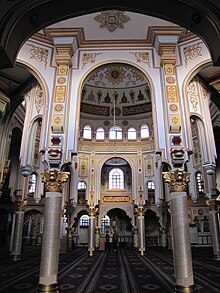
During the Qajar dynasty (1794 to 1925), Kermanshah Bazaar, mosques and tekyehs such as Tekyeh Biglarbeygi and Moaven al-molk Mosque, and beautiful houses such as Khajeh Barookh's House were built.
Tekyeh Biglarbeygi is well known for unique mirror decoration. Tekyeh Biglarbeygi was made during Qajar dynasty by efforts of Abdullah khan Biglarbeygi.
Tekyeh Moaven al-molk is unique because it has many pictures on the walls that relate to shahnameh, despite some of its more religious ones.
Khajeh Barookh's House is located in the old district of Faizabad, a Jewish neighborhood of the city. It was built by a Jewish merchant of the Qajar period, named Barookh/Baruch. The house, an historical depiction of Iranian architecture, was renamed "Randeh-Kesh House", after the last owner, is a "daroongara"(inward oriented) house and is connected through a vestibule to the exterior yard and through a corridor to the interior yard.[38] Surrounding the interior yard are rooms, brick pillars making the iwans(porches) of the house, and step-like column capitals decorated with brick-stalactite work. This house is among the rare Qajar houses with a private bathroom.


Bazaars
[edit]Kermanshah is home to at least one bazaar dating back to the Qajar period. Kermanshah Grand Bazaar or Tarike Bazaar was built around 1820 when Prince Mohammad Ali Mirza Dowlatshah of Qajar dynasty governed over Kermanshah, and used to be the largest grand bazaar of Middle East during its time.[39]
Churches
[edit]Economy
[edit]Kermanshah is one of the western agricultural core of Iran that produces grain, rice, vegetable, fruits, and oilseeds, however Kermanshah is emerging as a fairly important industrial city; there are two industrial centers with more than 256 manufacturing units in the suburb of the city. These industries include petrochemical refinery, textile manufacturing, food processing, carpet making, sugar refining, and the production of electrical equipment and tools. Kermanshah Oil Refining Company (KORC) established in 1932 by British companies, is one of the major industries in the city. After recent changes in Iraq, Kermanshah has become one of the main importing and exporting gates of Iran.
Education
[edit]Higher education
[edit]More than 49 thousands students are educating in 9 governmental and private universities in the city. Established in 1968 as the Kermanshah Graduate School of Nursing, the Kermanshah University of Medical Sciences was the first university in the west part of Iran. The medical school as a division of Razi University was established in 1976 and admitted some students in general practice. Razi University established in 1972 was the second university in the west part of Iran and is the most-prominent higher education institute in Kermanshah province and also west part of the country.[40] In 2020, Razi University ranked 24th in Iran and 1300th in the world by the U.S. News in universities of all countries of the world based upon 13 factors.[41]
Some of Kermanshah universities are:
- Islamic Azad University of Kermanshah[42]
- Kermanshah University of Medical Sciences
- Kermanshah University of Technology[43]
- Payame Noor University
- Razi University
Schools
[edit]Mohtashamiyeh (Persian: محتشمیه), established in 1899, was the first modern school in Kermanshah founded by Husseinali-Khan Mohandes-e Guran. Khalq Study Hall (Persian: قرائتخانۀ خلق) was the first study hall in Kermanshah and also an adult school founded in 1909.[44] Alliance Israélite school of Kermanshah founded by the Alliance Israélite Universelle in 1904.[45] The Azodiyeh State School for Misses (Persian: مدرسه دولتی دوشیزگان عضدیه) was the first girls' school, founded in 1922. The first private school in Kermanshah was founded in 1991.
Notable people
[edit]Arts
[edit]- Ali Mohammad Afghani, novelist
- Seyed Khalil Alinezhad, Tanbour master
- Mahshid Amirshahi, writer
- Nozar Azadi, actor
- Ali Ashraf Darvishian, novelist and writer
- Pouran Derakhshandeh, film director, producer, screenwriter
- Reza Shafiei Jam, actor
- Mirza Mohammad Reza Kalhor, calligrapher
- Mir Jalaleddin Kazzazi, writer
- Rahim Moeini Kermanshahi, poet, lyricist
- Alexis Kouros, writer, documentary-maker, director, and producer
- Abolghasem Lahouti, poet
- Doris Lessing, writer, 2007 winner of the Nobel Prize in Literature (born in Kermanshah to British parents)
- Aref Lorestani, actor, comedian
- Shahram Mokri, film director
- Nicky Nodjoumi, modern painter
- Reza Fieze Norouzi, actor
- Guity Novin, painter & graphic designer
- Mohammad Salemy, artist, curator, writer
- Rashid Yasemi, one of the Five-Masters of Persian Literature
Music
[edit]- Evin Agassi, singer
- Kayhan Kalhor, musician
- Mojtaba Mirzadeh, master of violin and setar
- Roknoddin Mokhtari, violin player
- Ali Akbar Moradi, musician and tanbour player
- Shahram Nazeri, vocalist and musician
- Sohrab Pournazeri, musician
- Sousan (Golandam Taherkhani), singer
- Marganita Vogt-Khofri, pianist, classical musician, and vocalist
- Bahramji, musician and santur player
Politics and military
[edit]- Ebrahim Azizi, member and spokesman of the Guardian Council
- Abdol Ali Badrei, commander of the Imperial Iranian Army and the Imperial Guard
- Amir Hossein Rabii, commander of the Imperial Iranian Air Force
- Hanif Bali, member of Swedish Riksdag
- Karim Sanjabi, Iran's attorney during oil nationalization movement, former foreign minister
- Bijan Namdar Zangeneh, minister of Petroleum
- Yar Mohammadkhan Kermanshahi A pivotal figure in the Iranian Constitutional Revolution[46]
Sciences
[edit]- Shahram Amiri, nuclear scientist
- Massoud Azarnoush, archaeologist
- Al-Dinawari, botanist, historian, geographer, astronomer and mathematician
- Fereidoun Biglari, archaeologist
Sports
[edit]- Makwan Amirkhani, mixed martial artist, UFC fighter
- Kourosh Bagheri, world weightlifting champion
- Homa Hosseini, rower
- Ali Mazaheri, 2006 Asian Games gold medalist, Asian champion & Olympic boxer
- Mohammad Hassan Mohebbi, light heavyweight freestyle wrestler & Iran's national team coach
- Mohammad Hossein Mohebbi, freestyle wrestler
- Yadollah Mohebbi, 125 kg freestyle wrestler and nephew of Mohammad Hossein Mohebbi and Mohammad Hassan Mohebbi
- Mohammad Ranjbar, former Iran national football team player and head coach
- Kianoush Rostami, world weight lifting champion
- Neda Shahsavari, table tennis champion
- Mohammad Torkashvand, volleyball champion
- Mehran Shahintab, Basketball champion & head coach of the Iranian national team Iran Basketball Federation
- Peter Warr, businessman, racing driver and a manager for several Formula One teams
- Saeid Ahmadi, world champion gold and silver medalist in karate
- Seyyedmasoud Derekeh, World Combat Games 2013 kickboxing champion silver medalist, WakoAsian kickboxing champion gold medalist, European Championship Tbilisi K-1 Georgia gold medalist, World Champion Iran 2011
Gallery
[edit]-
Historical panorama of Kermanshah in the late 19th century, by Antoin Sevruguin
-
Kermanshah photographed by Luigi Pesce between 1840-1860
-
Mount Dalekhani
-
Ghouri Ghaleh Cave
-
Close-Up of Bisotun Inscription
-
Taghbostan Carving [b]
See also
[edit]![]() Kermanshah travel guide from Wikivoyage
Kermanshah travel guide from Wikivoyage
![]() Media related to Kermanshah at Wikimedia Commons
Media related to Kermanshah at Wikimedia Commons
Notes
[edit]References
[edit]- ^ OpenStreetMap contributors (11 December 2024). "Kermanshah, Kermanshah County" (Map). OpenStreetMap (in Persian). Retrieved 11 December 2024.
- ^ a b Census of the Islamic Republic of Iran, 1395 (2016): Kermanshah Province. amar.org.ir (Report) (in Persian). The Statistical Center of Iran. Archived from the original (Excel) on 3 April 2022. Retrieved 19 December 2022.
- ^ Population and Housing Censuses at Statistical Center of Iran website.
- ^ Kermanshah can be found at GEOnet Names Server, at this link, by opening the Advanced Search box, entering "-3070245" in the "Unique Feature Id" form, and clicking on "Search Database".
- ^ Habibi, Hassan (19 November 2013) [Approved 21 June 1369]. Approval of the organization and chain of citizenship of the elements and units of the national divisions of Bakhtran province, centered in the city of Bakhtran. rc.majlis.ir (Report) (in Persian). Ministry of the Interior, Defense Political Commission of the Government Board. Proposal 3233.1.5.53; Letter 93808/907; Notification 82832/T122K. Archived from the original on 6 February 2013. Retrieved 29 January 2024 – via Research Center of the System of Laws of the Islamic Council of Farabi Mobile Library.
- ^ "Kermanshah, Iran Metro Area Population 1950-2021". www.macrotrends.net. Retrieved 23 July 2021.
- ^ a b Kia, Mehrdad (2016). The Persian Empire: A Historical Encyclopedia [2 volumes]. ABC-CLIO. pp. 236–237. ISBN 978-1610693912.
- ^ Brunner, Christopher (1983). "Geographical and Administrative divisions: Settlements and Economy". The Cambridge History of Iran: The Seleucid, Parthian, and Sasanian periods (2). Cambridge: Cambridge University Press. p. 767. ISBN 978-0-521-24693-4.
- ^ Everett-Heath, John (2018). "Kermānshāh". The Concise Dictionary of World Place-Names (4 ed.). Oxford University Press. ISBN 978-0191866326.
- ^ Daryaee, Touraj (2018). "Bahram IV". In Nicholson, Oliver (ed.). The Oxford Dictionary of Late Antiquity. Oxford: Oxford University Press. ISBN 978-0-19-866277-8.
- ^ Iran: Provinces and Cities population statistics
- ^ "New study sheds light on second Neanderthal tooth found in western iran". Tehran Times - 29 August 2021. Tehran Times. Retrieved 5 November 2021.
- ^ "Most ancient Mid East village discovered in western Iran". 2009. Archived from the original on 1 February 2010. Retrieved 23 May 2009.
- ^ "با 11800 سال قدمت، قديميترين روستاي خاورميانه در كرمانشاه كشف شد". 2009. Retrieved 23 May 2009. [dead link]
- ^ Dehkhoda: Kermanshah Archived 2011-05-11 at the Wayback Machine.
- ^ J. Limbert. (1968). The Origins and Appearance of the Kurds in Pre-Islamic Iran. Iranian Studies, 1.2: pp. 41-51.
- ^ G. Asatrian. (2009). Prolegemona to the Study of Kurds. Iran and the Caucasus, 13.1: pp. 1-58.
- ^ James, Boris. (2006). Uses and Values of the Term Kurd in Arabic Medieval Literary Sources. Seminar at the American University of Beirut, pp. 6-7.
- ^ Martin van Bruinessen, "The ethnic identity of the Kurds," in: Ethnic groups in the Republic of Turkey, compiled and edited by Peter Alford Andrews with Rüdiger Benninghaus [=Beihefte zum Tübinger Atlas des Vorderen Orients, Reihe B, Nr.60]. Wiesbaden: Dr. Ludwich Reichert, 1989, pp. 613–21. excerpt: "The ethnic label "Kurd" is first encountered in Arabic sources from the first centuries of the Islamic era; it seemed to refer to a specific variety of pastoral nomadism, and possibly to a set of political units, rather than to a linguistic group: once or twice, "Arabic Kurds" are mentioned. By the 10th century, the term appears to denote nomadic and/or transhumant groups speaking an Iranian language and mainly inhabiting the mountainous areas to the South of Lake Van and Lake Urmia, with some offshoots in the Caucasus. ... If there was a Kurdish-speaking subjected peasantry at that time, the term was not yet used to include them."[1] Archived 2015-10-15 at the Wayback Machine
- ^ Census of the Islamic Republic of Iran, 1385 (2006): Kermanshah Province. amar.org.ir (Report) (in Persian). The Statistical Center of Iran. Archived from the original (Excel) on 20 September 2011. Retrieved 25 September 2022.
- ^ Census of the Islamic Republic of Iran, 1390 (2011): Kermanshah Province. irandataportal.syr.edu (Report) (in Persian). The Statistical Center of Iran. Archived from the original (Excel) on 18 January 2023. Retrieved 19 December 2022 – via Iran Data Portal, Syracuse University.
- ^ Geomatics and Cartographic Research Centre, Carleton University. "Atlas of the Languages of Iran". iranatlas.net. Retrieved 2 March 2024.
- ^ "معاون امور عمرانی استانداری: کرمانشاه بزرگترین شهر کردنشین جهان است - ایرنا". شهرخبر. Retrieved 29 May 2019.
- ^ "کرمانشاه؛ پرجمعیت ترین شهر کردنشین ایران". خبرگزاری مهر | اخبار ایران و جهان | Mehr News Agency (in Persian). 23 March 2012. Retrieved 29 May 2019.
- ^ "اورمیا - بزرگترین شهر کردنشین جهان مشخص شد". Archived from the original on 27 March 2016. Retrieved 18 March 2016.
- ^ Iran Chamber society: accessed: September 2010.
- ^ روزنامه سلام کرمانشاه Archived 2010-06-21 at the Wayback Machine Persian (Kurdish)
- ^ آشنایی با فرهنگ و نژاد استان کرمانشاه Archived 2018-09-01 at the Wayback Machine(Persian)
- ^ سازمان میراث فرهنگی، صنایع دستی و گردشگری استان کرمانشاه[permanent dead link] بازدید 2010/03/11
- ^ "Arrest of the Assyrian leader of the Kermanshah Church in iran". Assistnews.net. Archived from the original on 29 September 2011. Retrieved 2 December 2011.
- ^ RRT RESEARCH RESPONSE, Refugee Review Tribunal, www.justice.gov
- ^ "آشنایی با فرهنگ و نژاد استان کرمانشاه". www.artkermanshah.ir. Archived from the original on 1 September 2018. Retrieved 29 May 2019.
- ^ a b
- "Highest record temperature in Kermanshah by Month 1951–2010". Iran Meteorological Organization. Archived from the original on April 14, 2015. Retrieved April 7, 2015.
- "Lowest record temperature in Kermanshah by Month 1951–2010". Iran Meteorological Organization. Archived from the original on April 14, 2015. Retrieved April 7, 2015.
- ^ "World Meteorological Organization Climate Normals for 1991-2020: Kermanshah" (CSV). ncei.noaa.gov. NOAA. Retrieved 25 March 2024.
- ^ "No. of days with snow or sleet in Kermanshah by Month 1951–2010". Iran Meteorological Organization. Archived from the original on April 14, 2015. Retrieved April 7, 2015.
- ^ "طاق بستان کجاست؟ | وبلاگ اسنپ تریپ". Retrieved 17 May 2021.
- ^ "Jame-Shafeie Mosque".
- ^ "سازمان ميراث فرهنگي، گردشگري و صنايع دستي استان كرمانشاه". Kermanshahmiras.ir. Archived from the original on 27 September 2007. Retrieved 2 December 2011.
- ^ Salehnezhad, Narges (25 June 2016). "تاریکه بازار؛ معرف تاریخ شهر کرمانشاه". Kojaro.
- ^ "About the university". Kermanshah University of Medical Sciences (in Persian). Archived from the original on 29 January 2013.
- ^ "Razi University". US News. 2020.
- ^ "iauksh.ac.ir". Archived from the original on 7 October 2014. Retrieved 27 October 2006.
- ^ kut.ac.ir
- ^ Mohammad-Ja'far Panahi. "Libraries of Kermanshah". Encyclopedia of Library and information science (in Persian). Archived from the original on 19 January 2011. Retrieved 1 September 2010.
- ^ Nahid Pirnazar (15 June 2017). "Kermanshah, The Jewish Community". Encyclopædia Iranica.
- ^ "Lost in history; Yar Mohammad khan, an unknown but brass hat of Persian Constitutional Revolution". پایگاه خبری تحلیلی منشور توسعه آنلاینmanshooretoseehonline (in Persian). 17 July 2022. Retrieved 8 August 2023.
Sources
[edit]- Borijan, Habib (2015). "KERMANSHAH i. Geography". Encyclopaedia Iranica.
- Borijan, Habib (2016). "KERMANSHAH vii. Languages and Dialects". Encyclopaedia Iranica.
- Calmard, Jean (2015). "KERMANSHAH iv. History from the Arab Conquest to 1953". Encyclopaedia Iranica.
- Pirnazar, Nahid (2014). "KERMANSHAH viii. The Jewish Community". Encyclopaedia Iranica.
External links
[edit]- [2]
- Pictures of Inscription and Bas relief of Darius the Great - Free Pictures of IRAN irantooth.com
- Photos from Bisotun Complex - From Online Photo Gallery Of Aryo.ir
- Photos from Taqwasan - From Online Photo Gallery Of Aryo.ir
- Photos from Moavenol Molk Tekieh - From Online Photo Gallery Of Aryo.ir












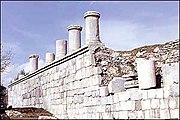


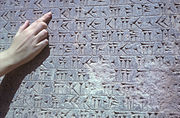
![Taghbostan Carving [b]](http://upload.wikimedia.org/wikipedia/commons/thumb/6/66/Harp-Sassanid.png/180px-Harp-Sassanid.png)
